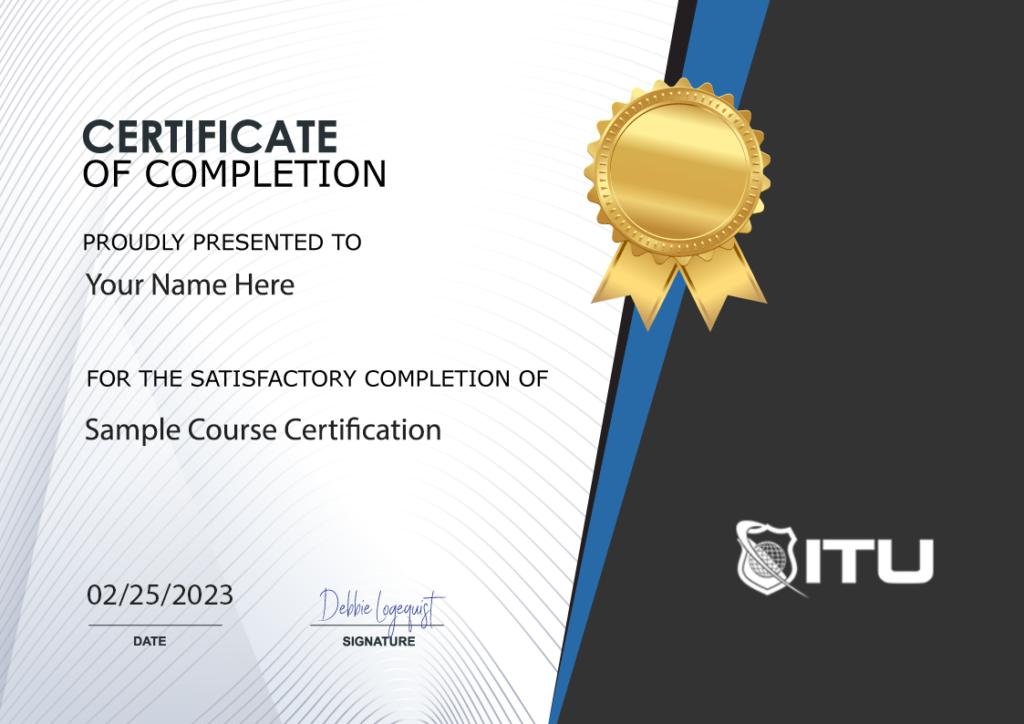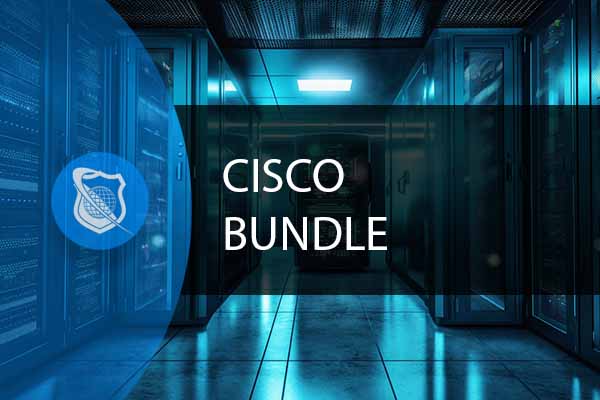Ultimate Cisco Training Series – 11 Courses
The 11-course Cisco Master Training Bundle is a complete resource for all your Cisco training needs. This bundle will give you the skills needed to master the most popular Cisco certifications available today.
Included In This Course



Closed Captions



Certificate of Completion
Networking is the foundation of the IT world, and Cisco training certification is a demonstration that you have the skills and expertise to succeed in this field. If you work as an IT professional focused on networking, more likely than not your career will bring you into contact with Cisco systems at some stage.
About our Cisco Courses
Our Cisco training series provides students with an in-depth knowledge of working with one of the most powerful and respected technologies. Cisco certifications in the IT industry and some of the most sought-after certifications available in the IT field today! Cisco Certifications bring valuable, measurable rewards to network professionals, their managers, and the organizations that employ them. The 11-course Cisco Master Training Bundle is a complete resource for all your Cisco training needs. This bundle will give you the skills needed to master the most popular Cisco certifications available today.
Prepare for success with Cisco Certification Training! Our comprehensive program offers skill-based courses that will help you get the most out of your learning experience, no matter what level or path you’re on. Unlock new opportunities in IT and network engineering by refining your skills today!
Includes all of our 11 Cisco courses listed below:
- Cisco 200-301: -CCNA – Cisco Certified Network Associate
- Cisco 200-355: Implementing Cisco Wireless Network Fundamentals
- Cisco 210-060 CICD: Implementing Cisco Collaboration Devices
- Cisco 210-065 CIVND: Implementing Cisco Video Network Devices
- Cisco 210-260 IINS: Implementing Cisco Network Security
- Cisco 300-101: CCNP – ROUTE – Implementing Cisco IP Routing
- Cisco 300-115: CCNP – SWITCH – Routing and Switching
- Cisco 300-135: CCNP – TSHOOT – Troubleshooting and Maintaining Cisco IP Networks
- Cisco 350-401: Implementing Cisco Enterprise Network Core Technologies (ENCOR) (CCNP)
- Cisco 640-461: CCNA Voice – ICOMM v8.0 – Cisco Voice and Unified Communications Administration
- Cisco 640-864: CCDA Cisco Certified Design Associate
About Cisco Certifications and levels
Achieving a Cisco certification is an excellent way for networking professionals to boost their marketability and take on more responsibility. The four levels of certifications include Entry, Associate, Professional (CCNP), and the highest level – Expert (CCIE). For those starting out in this field, they can begin with entry-level or associate-level certifications before progressing onto professional-level training programs. By pursuing the CCIE coursework specifically designed by Cisco experts, you will soon become an expert yourself as you reach the pinnacle of your career path!
Cisco entry-level certifications are ideal for new professionals seeking to advance their skills and knowledge in networking. Individually, these credentials provide valuable insight into the fundamentals of IT which can help propel you towards Associate-level certification and give you a leg up on others vying for success in your chosen field.
Cisco Associate certifications confirm the expertise and abilities that networking professionals acquire in their first twelve months of work. IT experts rely on associate-level qualifications to progress from technical or junior specialists to higher-ranking or specialized network administrator roles. With these certifications, you can take your career to a whole new level!
With Cisco Professional certifications, IT professionals can hone their skills and take on elevated roles as network engineers or Tier 3 technicians. This level is the perfect opportunity to showcase your expertise while expanding your career.
Frequently Asked Questions About Ultimate Cisco Training Series – 11 Courses
What is included in the Ultimate Cisco Training Series?
The Ultimate Cisco Training Series includes 11 comprehensive courses designed to provide you with the skills needed to master the most popular Cisco certifications available today. This includes 202 training hours, 757 videos, 146 topics, and 1,790 practice questions.
How can I access the Ultimate Cisco Training Series?
You can access the Ultimate Cisco Training Series and over 2,500 hours of on-demand content with the All Access Monthly Subscription. The subscription starts with a 7-day free trial and you can cancel anytime.
Why is Cisco certification important in the IT industry?
Cisco certification is a demonstration of your proficiency in networking fundamentals and concepts. Being Cisco certified assures employers of your expertise in installing, configuring, operating, and troubleshooting routed and switched networks. It also equips professionals with the knowledge needed to handle real-world networking issues in large organizations.
How can Cisco certification help my career?
Achieving a Cisco certification can put your career on a fast track. It provides better visibility for your job profile, allows you to perform a variety of advanced networking tasks with increased responsibility, and can speed up the promotion process. Many firms, especially Cisco partners, prefer to hire Cisco certified professionals, and the more certifications you achieve, the better your salary may be.
What are the potential financial benefits of obtaining a Cisco certification?
Although the experience varies from person to person, the average professional with a Cisco certification can expect a significant increase in salary. With an average starting pay of more than $50,000 annually, achieving a Cisco certification could mean a substantial financial improvement even after considering the opportunity cost of preparation time.
Who can benefit from the Ultimate Cisco Training Series?
The Ultimate Cisco Training Series is beneficial for IT professionals focused on networking. Whether you are a beginner or an experienced professional, the comprehensive program offers skill-based courses that will help you get the most out of your learning experience, no matter what level or path you’re on. The training series can unlock new opportunities in IT and network engineering by refining your skills.
Blogs of Interest Related to This Course
Proudly DisplayYour Achievement
Upon completion of your training, you’ll receive a personalized certificate of completion to help validate to others your new skills.
Cisco 350-401: Implementing Cisco Enterprise Network Core Technologies (ENCOR) (CCNP) Course Content
Module 1: Architecture
- 1.1 About Your Instructor
- 1.2 Course Introduction
- 1.3 Welcome to the Architecture Domain
- 1.4 Classic 3 and 2 Tier Models
- 1.5 2 Tier Spine Leaf
- 1.6 Fabric Capacity Planning
- 1.7 High Availability
- 1.8 Designing a WLAN Deployment
- 1.9 Cloud vs On-Prem
- 1.10 The Cisco SD-WAN
- 1.11 Cisco SD-Access
- 1.12 QoS
- 1.13 Hardware vs Software Switching
Module 2: Virtualization
- 2.1 Welcome to the Virtualization Domain
- 2.2 Device Virtualization Technologies
- 2.3 Data Path Virtualization
- 2.4 Network Virtualization Concepts
Module 3: Infrastructure
- 3.1 Welcome to the Infrastructure Domain
- 3.2 Trunking - VTP - EtherChannel
- 3.3 RSTP and MST
- 3.4 EIGRP vs OSPF
- 3.4 OSPF
- 3.5 eBGP
- 3.6 eBGP Part 2
- 3.7 WLANs
- 3.8 NTP NAT PAT
- 3.9 HSRP VRRP GLBP
- 3.10 Multicast
Module 4: Network Assurance
- 4.1 Welcome to the Network Assurance Module
- 4.2 Diagnose Network Issues
- 4.3 NetFlow
- 4.4 SPAN
- 4.5 IP SLA
- 4.6 DNA Center
Module 5: Security
- 5.1 Welcome to the Security Module
- 5.2 Device Access Control
- 5.3 ACLs and CoPP
- 5.4 Wireless Security
- 5.5 Components in Security Design
Module 6: Automation
- 6.1 Welcome to the Automation Module
- 6.2 Python
- 6.3 JSON
- 6.4 YANG
- 6.5 NETCONF-RESTCONF
- 6.6 APIs
- 6.7 EEM
- 6.8 Orchestration Tools
Cisco 200-301: Cisco Certified Network Associate (CCNA) Course Content
Module 1: Exploring the Functions of Networking
- Course Introduction
- Instructor Introduction
- Exploring the Functions of Networking Pt 1
- Exploring the Functions of Networking Pt 2
Module 2: Introducing the Host-To-Host Communications Model
- Introducing the Host-To-Host Communications Model Pt 1
- Introducing the Host-To-Host Communications Model Pt 2
Module 3: Introducing LANs
- Introducing LANs
- Get Started with CLI Demo Pt 1
- Get Started with CLI Pt Demo 2
- Adding Descriptions to Interfaces Demo
- Configure Gateway on a Switch Demo
- Visualize Interfaces and Statistics Demo
- Show Version Command Demo
- CDP Demo
Module 4: Exploring the TCP/IP Link Layer
- Exploring the TCP-IP Link Layer Pt 1
- Exploring the TCP-IP Link Layer Pt 2
Module 5: Subnetting
- Subnetting Pt 1
- Subnetting Pt 2
- Subnetting Pt 3
- Subnetting Pt 4
- Subnetting Pt 5
- Subnetting Pt 6
Module 6: Explaining the TCP/IP Transport Layer and Application Layer
- Explaining the TCP-IP Transport Layer and Application Layer Pt 1
- Explaining the TCP-IP Transport Layer and Application Layer Pt 2
- Explaining the TCP-IP Transport Layer and Application Layer Pt 3
Module 7: Exploring the Functions of Routing
- Exploring the Functions of Routing Pt 1
- Exploring the Functions of Routing Pt 2
- Exploring the Functions of Routing Pt 3
- Configuring RIP Demo
- EIGRP Demo Pt 1
- EIGRP Demo Pt 2
Module 8: Exploring the Packet Delivery Process
- Exploring the Packet Delivery Process
Module 9: Troubleshooting a Simple Network
- Troubleshooting a Simple Network
Module 10: Introducing Basic IPv6
- Introducing Basic IPv6 Pt 1
- Introducing Basic IPv6 Pt 2
- Introducing Basic IPv6 Pt 3
- Introducing Basic IPv6 Pt 4
- Introducing Basic IPv6 Pt 5
- Introducing Basic IPv6 Pt 6
- Introducing Basic IPv6 Pt 7
- Introducing Basic IPv6 Pt 8
- IPV6 Basic Configuration and SLAAC Demo Pt 1
- IPV6 Basic Configuration and SLAAC Demo Pt 2
- IPV6 Routing Demo Pt 1
- IPV6 Routing Demo Pt 2
- IPV6 Static Routes Demo
Module 11: Configuring Static Routing
- Configuring Static Routing
- Static Routes Demo
Module 12: Implementing VLANs and Trunks
- Implementing VLANs and Trunks Pt 1
- Implementing VLANs and Trunks Pt 2
- Implementing VLANs and Trunks Pt 3
- Implementing VLANs and Trunks Pt 4
- Spanning-tree Protocol Demo Pt 1
- Spanning-tree Protocol Demo Pt 2
- Spanning-tree Protocol Demo Pt 3
Module 13: Routing Between VLANs
- Routing Between VLANs
- Inter VLAN Routing Demo
Module 14: Introducing OSPF
- Introducing OSPF Pt 1
- Introducing OSPF Pt 2
- Introducing OSPF Pt 3
- Introducing OSPF Pt 4
- OSPF Single Area Demo Pt 1
- OSPF Single Area Demo Pt 2
- OSPF Multiple Area Demo Pt 1
- OSPF Multiple Area Demo Pt 2
Module 15: Building Redundant Switched Topologies
- Building Redundant Switched Topologies Pt 1
- Building Redundant Switched Topologies Pt 2
Module 16: Improving Redundant Switched Topologies with EtherChannel
- Improving Redundant Switched Topologies with Ether Channel Pt 1
- Improving Redundant Switched Topologies with Ether Channel Pt 2
- Configuring Ether Channel Demo
Module 17: Exploring Layer 3 Redundancy
- Exploring Layer 3 Redundancy
Module 18: Introducing WAN Technologies
- Introducing WAN Technologies Pt 1
- Introducing WAN Technologies Pt 2
- Introducing WAN Technologies Pt 3
- Introducing WAN Technologies Pt 4
- Introducing WAN Technologies Pt 5
- Introducing WAN Technologies Pt 6
Module 19: Explaining Basics of ACL
- Explaining Basics of ACL Pt 1
- Explaining Basics of ACL Pt 2
- Explaining Basics of ACL Pt 3
Module 20: Enabling Internet Connectivity
- Enabling Internet Connectivity
- DHCP Demo
- Static NAT Demo
- PAT Using Specific IP Demo
- PAT Using IP of Interface Demo
Module 21: Introducing QoS
- Introducing QoS Pt 1
- Introducing QoS Pt 2
- Introducing QoS Pt 3
- Introducing QoS Pt 4
- Introducing QoS Pt 5
Module 22: Introducing Architectures and Virtualization
- Introducing Architectures and Virtualization Pt 1
- Introducing Architectures and Virtualization Pt 2
- Introducing Architectures and Virtualization Pt 3
- Introducing Architectures and Virtualization Pt 4
Module 23: Introducing System Monitoring
- Introducing System Monitoring Pt 1
- Introducing System Monitoring Pt 2
- Introducing System Monitoring Pt 3
Module 24: Managing Cisco Devices
- Managing Cisco Devices Pt 1
- Managing Cisco Devices Pt 2
- NTP Demo
- Syslog Demo
Module 25: Examining the Security Threat Landscape
- Examining the Security Threat Landscape Pt 1
- Examining the Security Threat Landscape Pt 2
Module 26: Implementing Threat Defense Technologies
- Implementing Threat Defense Technologies Pt 1
- Implementing Threat Defense Technologies Pt 2
- Implementing Threat Defense Technologies Pt 3
- Implementing Threat Defense Technologies Pt 4
- Implementing Threat Defense Technologies Pt 5
- Authentication Protocols Demo Pt 1
- Authentication Protocols Demo Pt 2
- Device Hardening Demo Pt 1
- Device Hardening Demo Pt 2
- Device Hardening Demo Pt 3
- Port Security Demo
Module 27: Exam Preparation
- Exam Prep Tips
Module 28: Practice Demos
- Get Started with CLI Demo Pt 1
- Get Started with CLI Pt Demo 2
- Adding Descriptions to Interfaces Demo
- Configure Gateway on a Switch Demo
- Visualize Interfaces and Statistics Demo
- Show Version Command Demo
- CDP Demo
- Static Routes Demo
- DHCP Demo
- Static NAT Demo
- PAT Using Specific IP Demo
- PAT Using IP of Interface Demo
- Configuring RIP Demo
- Configuring Ether Channel Demo
- Inter VLAN Routing Demo
- Spanning-tree Protocol Demo Pt 1
- Spanning-tree Protocol Demo Pt 2
- Spanning-tree Protocol Demo Pt 3
- EIGRP Demo Pt 1
- EIGRP Demo Pt 2
- Authentication Protocols Demo Pt 1
- Authentication Protocols Demo Pt 2
- NTP Demo
- Syslog Demo
- Device Hardening Demo Pt 1
- Device Hardening Demo Pt 2
- Device Hardening Demo Pt 3
- Port Security Demo
- OSPF Single Area Demo Pt 1
- OSPF Single Area Demo Pt 2
- OSPF Multiple Area Demo Pt 1
- OSPF Multiple Area Demo Pt 2
- IPV6 Basic Configuration and SLAAC Demo Pt 1
- IPV6 Basic Configuration and SLAAC Demo Pt 2
- IPV6 Routing Demo Pt 1
- IPV6 Routing Demo Pt 2
- IPV6 Static Routes Demo
Cisco 210-060 CICD: Implementing Cisco Collaboration Devices Course Content
Module 1: Introducing Cisco Collaboration Architecture
- Course Introduction
- Introducing Cisco Collaboration Architecture Part 1
- Introducing Cisco Collaboration Architecture Part 2
- Small To Mid-Size Business Part 1
- Small To Mid-Size Business Part 2
- Small To Mid-Size Business Part 3
- Cisco Unified Communications Manager Part 1
- Cisco Unified Communications Manager Part 2
- Cisco Unified Communications Manager Part 3
- Cisco Unified Connection
- Lab Introduction
Module 2: Telephony And Call Routing
- Telephony 101 Part 1
- Telephony 101 Part 2
- Telephony 101 Part 3
- Telephony 101 Part 4
- Telephony 101 Part 5
- Telephony 101 Part 6
- Call Routing 101 Part 1
- Call Routing 101 Part 2
- VoIP Call Routing 101
- Call Routing With DNS
- Deployment Scenarios Part 1
- Deployment Scenarios Part 2
- Deployment Scenarios Part 3
- Gateway Call Routing Basics Part 1
- Gateway Call Routing Basics Part 2
- Gateway Call Routing Basics Part 3
- Gateway Call Routing Basics Part 4
- Configuring The Gateway Lab Part 1
- Configuring The Gateway Lab Part 2
Module 3: Preparing The Network And Phone Behavior
- Preparing The Network For Voices Part 1
- Preparing The Network For Voices Part 2
- IP Phone Behavior
- Configuring The LAN Lab
- Standing Up The Platform Lab
- Using OVA Templates To Deploy CUCM-CUC-IMP Lab Part 1
- Using OVA Templates To Deploy CUCM-CUC-IMP Lab Part 2
- Using OVA Templates To Deploy CUCM-CUC-IMP Lab Part 3
- Using OVA Templates To Deploy CUCM-CUC-IMP Lab Part 4
- Using OVA Templates To Deploy CUCM-CUC-IMP Lab Part 5
- Using OVA Templates To Deploy CUCM-CUC-IMP Lab Part 6
- Using OVA Templates To Deploy CUCM-CUC-IMP Lab Part 7
- Using OVA Templates To Deploy Prime Collaboration Provisioning Lab Part 1
- Using OVA Templates To Deploy Prime Collaboration Provisioning Lab Part 2
Module 4: CUCM Administration Interfaces
- CUCM Administration Interfaces Part 1
- CUCM Administration Interfaces Part 2
- CUCM Stand Up
- CUCM Stand Up Lab
- End User Interfaces
- End User Configuration Lab
- AD Integration Lab
- End Point Implementation Part 1
- End Point Implementation Part 2
- IMP Integration Lab
- CUC Integration Lab Part 1
- CUC Integration Lab Part 2
- IP Communicator Lab
- Profiles And Templates Lab
- CUCME Phone Configuration
- Configuring CUCME Lab Part 1
- Configuring CUCME Lab Part 2
- CUCM End-User Portal Lab
- Configuring CUCM Phones From Scratch
- Configuring Cisco SX20 Codec Part 1
- Configuring Cisco SX20 Codec Part 2
Module 5: Call Configuration
- Advanced Call Coverage Part 1
- Advanced Call Coverage Part 2
- Advanced Call Coverage Part 3
- Call Coverage Lab Part 1
- Call Coverage Lab Part 2
- Call Coverage Lab Part 3
- Call Coverage Lab Part 4
- Call Coverage Lab Part 5
- Calling Constrictions And COS Part 1
- Calling Constrictions And COS Part 2
- Implementing Class Of Control Lab Part 1
- Implementing Class Of Control Lab Part 2
- Connecting To The PSTN Part 1
- Configuring Voice Gateway Features Lab Part 1
- Configuring Voice Gateway Features Lab Part 2
- Configuring Voice Gateway Features Lab Part 3
- Connecting To The PSTN Part 2
- PSTN Calling And Digit Manipulation Lab Part 1
- PSTN Calling And Digit Manipulation Lab Part 2
- PSTN Dial Plan Configuration Lab Part 1
- PSTN Dial Plan Configuration Lab Part 2
- Course Conclusion
Cisco 210-065 CIVND: Implementing Cisco Video Network Devices Course Content
Module 1: Pre-Course Chapter 1
- Course Introduction
- Civnd Intro Part 1
- Civnd Intro Part 2
- The Big Picture
Module 2: Pre-Course Chapter 2
- All About Video Part 1
- All About Video Part 2
- All About Video Part 3
- All About Video Part 4
Module 3: Cisco Video And Content Delivery
- Cisco Video And Content Delivery Part 1
- Cisco Video And Content Delivery Part 2
- Cisco Video And Content Delivery Part 3
Module 4: Cisco Video Surveillance
- Cisco Video Surveillance Part 1
- Cisco Video Surveillance Part 2
Module 5: Cisco Collaboration
- Cisco Collaboration Part 1
- Cisco Collaboration Part 2
- Cisco Collaboration Part 3
Module 6: Central Collaboration Endpoint Control
- Central Collaboration Endpoint Control
Module 7: Unified IP Phones, Desk Endpoints And Cisco Jabber
- Unified IP Phones Desk Endpoints And Cisco Jabber
Module 8: Configuring Unified IP Phones And Cisco Jabber
- Configuring Unified IP Phones And Cisco Jabber Part 1
- Configuring Unified IP Phones And Cisco Jabber Part 2
Module 9: Operating And Troubleshooting Cisco Unified IP Phone And Cisco Jabber
- Operating And Troubleshooting Cisco Unified IP Phone And Cisco Jabber Part 1
- Operating And Troubleshooting Cisco Unified IP Phone And Cisco Jabber Part 2
- Operating And Troubleshooting Cisco Unified IP Phone And Cisco Jabber Part 3
Module 10: Cisco Telepresence Endpoints Installation And Characteristics
- Cisco Telepresence Endpoints Installation And Characteristics Part 1
- Cisco Telepresence Endpoints Installation And Characteristics Part 2
- Cisco Telepresence Endpoints Installation And Characteristics Part 3
- Cisco Telepresence Endpoints Installation And Characteristics Part 4
Module 11: Configuring Cisco Telepresence CTS And Cisco DX650 Endpoints
- Configuring Cisco Telepresence CTs And Cisco D X650 Endpoints Part 1
- Configuring Cisco Telepresence CTs And Cisco D X650 Endpoints Part 2
Module 12: Configuring Cisco Telepresence TC Endpoints
- Configuring Cisco Telepresence TC Endpoints Part 1
- Configuring Cisco Telepresence TC Endpoints Part 2
- Configuring Cisco Telepresence TC Endpoints Part 3
- Configuring Cisco Telepresence TC Endpoints Part 4
- Configuring Cisco Telepresence TC Endpoints Part 5
- Configuring Cisco Telepresence TC Endpoints Part 6
Module 13: Operating And Troubleshooting Cisco Telepresence Endpoints
- Operating And Troubleshooting Cisco Telepresence Endpoints Part 1
- Operating And Troubleshooting Cisco Telepresence Endpoints Part 2
- Operating And Troubleshooting Cisco Telepresence Endpoints Part 3
- Operating And Troubleshooting Cisco Telepresence Endpoints Part 4
- Operating And Troubleshooting Cisco Telepresence Endpoints Part 5
Module 14: Cisco Multipoint Conferencing Solutions
- Cisco Multipoint Conferencing Solutions Part 1
- Cisco Multipoint Conferencing Solutions Part 2
- Cisco Multipoint Conferencing Solutions Part 3
Module 15: Configuring And Monitoring Cisco Multipoint
- Configuring And Monitoring Cisco Multipoint Part 1
- Configuring And Monitoring Cisco Multipoint Part 2
Module 16: Cisco DMP Characteristics And Installation
- Cisco DMP Characteristics And Installation Part 1
- Cisco DMP Characteristics And Installation Part 2
Module 17: Configuring Cisco DMPs
- Configuring Cisco DMP's
Module 18: Managing Cisco Edge 340 DMPs
- Managing Cisco Edge340 DMPs
- Course Conclusion
Module 19: Labs
- Basic Switch Port Configuration
- Dashboard Options Part 1
- Dashboard Options Part 2
- Preparations For Endpoints Part 1
- Preparations For Endpoints Part 2
- Preparations For Endpoints Part 3
- Preparations For Endpoints Part 4
- Basic Troubleshooting
- Setup TC Endpoint Part 1
- Setup TC Endpoint Part 2
- Setup TC Endpoint Part 3
- Setup TC Endpoint Part 4
Cisco 210-260 IINS: Implementing Cisco Network Security Course Content
Module 1: Network Review
- Course Introduction
- Network Review Part 1
- Network Review Part 2
- Network Review Part 3
- Network Review Part 4
Module 2: Terminology And Fundamentals
- Terminology And Fundamentals Part 1
- Terminology And Fundamentals Part 2
- Terminology And Fundamentals Part 3
- Terminology And Fundamentals Part 4
- Terminology And Fundamentals Part 5
- Terminology And Fundamentals Part 6
- Terminology And Fundamentals Part 7
Module 3: PKI And Cryptography
- Pki And Cryptography Part 1
- Pki And Cryptography Part 2
Module 4: AAA
- AAA Part 1
- AAA Part 2
- AAA Part 3
Module 5: Bring Your Own Device
- Bring Your Own Device Part 1
- Bring Your Own Device Part 2
- Bring Your Own Device Part 3
Module 6: Secure Access
- Secure Access Part 1
- Secure Access Part 2
- Secure Access Part 3
- Secure Access Demo
Module 7: VPNs
- VPN Concepts Part 1
- VPN Concepts Part 2
- Remote Access VPNs Part 1
- Remote Access VPNs Part 2
- Site To Site VPNs
Module 8: Secure Routing And Switching
- Secure Routing And Switching Part 1
- Secure Routing And Switching Part 2
- Secure Routing And Switching Demo 1
- Secure Routing And Switching Demo 2
- Layer2 Attacks Part 1
- Layer2 Attacks Part 2
- Layer2 Attacks Part 3
- Mitigation Part 1
- Mitigation Part 2
Module 9: Firewalls
- Firewall Technologies Part 1
- Firewall Technologies Part 2
- Implementing Nat Part 1
- Implementing Nat Part 2
- Zone Based Firewall
- Firewall Features On The ASA Part 1
- Firewall Features On The ASA Part 2
- Firewall Features On The ASA Part 3
Module 10: Intrusion Protection System (IPS)
- Intrusion Protection System Part 1
- Intrusion Protection System Part 2
Module 11: Content And Endpoint Security
- Content And Endpoint Security Part 1
- Content And Endpoint Security Part 2
- Course Conclusion
Cisco 200-355: Implementing Cisco Wireless Network Fundamentals Course Content
Module 1: Wireless Basics
- Course And Instructor Introduction
- Wireless Basics Part 1
- Wireless Basics Part 2
- Wireless Basics Part 3
- Wireless Basics Part 4
- Wireless Basics Part 5
- Wireless Basics Part 6
Module 2: Wireless Standards
- Wireless Standards Part 1
- Wireless Standards Part 2
- Wireless Standards Part 3
- Wireless Standards Part 4
- Wireless Standards Part 5
Module 3: Wireless Signals
- Wireless Signals Part 1
- Wireless Signals Part 2
Module 4: Antennas
- Antennas Part 1
- Antennas Part 2
- Antennas Part 3
Module 5: Topologies
- Topologies Part 1
- Topologies Part 2
Module 6: Frame Types
- Frame Types Part 1
- Frame Types Part 2
- Frame Types Part 3
Module 7: Planning Coverage
- Planning Coverage Part 1
- Planning Coverage Part 2
- Planning Coverage Part 3
Module 8: Architectures
- Architectures Part 1
- Architectures Part 2
- Architectures Part 3
Module 9: Stand Alone And Cloud Deployments
- Stand Alone And Cloud Deployments Part 1
- Stand Alone And Cloud Deployments Part 2
Module 10: Controller Based Deployment
- Controller Based Deployment Part 1
- Controller Based Deployment Part 2
- Controller Based Deployment Part 3
Module 11: Controller Discovery
- Controller Discovery Part 1
- Controller Discovery Part 2
- Controller Discovery Part 3
Module 12: Roaming
- Roaming Part 1
- Roaming Part 2
Module 13: Radio Resource Management
- Radio Resource Management Part 1
- Radio Resource Management Part 2
- Radio Resource Management Part 3
Module 14: Wireless Security
- Wireless Security Part 1
- Wireless Security Part 2
- Wireless Security Part 3
Module 15: WLAN Configuration
- WLAN Configuration
Module 16: Guest Networks
- Guest Networks
Module 17: Client Connectivity
- Client Connectivity Part 1
- Client Connectivity Part 2
Module 18: Managing Wireless
- Managing Wireless Part 1
- Managing Wireless Part 2
Module 19: Interference
- Interference Part 1
- Interference Part 2
Module 20: Troubleshooting
- Troubleshooting Part 1
- Troubleshooting Part 2
- Course Conclusion
Cisco 300-115: CCNP - SWITCH - Routing and Switching Course Content
Module 1: Plan And Design
- Course And Instructor Introduction
- Planning For Complex Network-Part1
- Planning For Complex Network-Part2
- Intro To Cisco Enterprise Architecture And CAM-Part1
- Intro To Cisco Enterprise Architecture And CAM-Part2
- Review Networking Topology-Part1
- Review Networking Topology-Part2
- Review OSI Model
- Review SLA
- Network Discovery
- NTP Explained-Part1
- NTP Explained-Part2
- Network Security-Part1
- Network Security-Part2
Module 2: Switch Configuration
- VLAN And Trunking-Part1
- VLAN And Trunking-Part2
- VTP Intro And Config
- Ether Channel Configuration And Load Balancing
- More Ether Channel Configuration-Part1
- More Ether Channel Configuration-Part2
- Port Security
- Root Guard
- Configuring MST
Module 3: IP Configuration
- DHCP Intro And Config-Part1
- DHCP Intro And Config-Part2
- IPV6 Intro And Config-Part1
- IPV6 Intro And Config-Part2
- Configure DHCP
- Configure DHCPV6
- Configure IPSLA
- NTP Configuration
- Network Monitoring Using IPSLA-Part1
- Network Monitoring Using IPSLA-Part2
- Network Monitoring Using IPSLA-Part3
Module 4: STP And RTP
- Config Routing Between VLANs With A Router
- Improves STP Config-Part1
- Improve STP Config-Part2
- Improve STP Config-Part3
- Improve STP Config-Part4
- Implement RSTP
- Intro And Config MST
Module 5: Routing
- Config Routing Between VLANs With A Router
- Routing On A Multi Layer Switch
- Routing With An External Router
- Further Routing On Multilayer Switch
Module 6: HSRP, VRRP, GLBP
- Configure And Tune HSRP
- Configure HSRP With Load Balancing
- HSRP For IPv6
- Configure VRRP
- Configure VRRP With Load Balancing
- Implement GLBP
- Configure GLBP
Module 7: Course Review
- Designing Complex Networks
- Review Demo CAM
- Review Demo VLANs And Trunking
- Review Demo VTP Configure
- Review Demo Ether Channel And Load Balancing
- Review Demo RSTP
- Review Demo Routing Between VLANs With A Router
- Course Outro
Cisco 300-135: CCNP - TSHOOT - Troubleshooting and Maintaining Cisco IP Networks Course Content
Module 1: Introduction to Cisco Troubleshooting
- Introduction
- Troubleshooting And Maintenance
- IOS Troubleshooting Commands
- Remote Data Gathering
- Introduction To Graphical Troubleshooting Tools And Review
Module 2: Troubleshooting Switches
- Troubleshoot Catalyst Switches
- Troubleshoot TCAM
Module 3: Troubleshooting VLANS and Trunking
- Troubleshooting VLANs And Trunking-Part1
- Troubleshooting VLANs And Trunking-Part2
- Troubleshooting VLANs And Trunking-Part3
- Trouble Ticket 1 VLANS
Module 4: Troubleshooting Spanning Tree Protocol, EtherChannel
- Spanning Tree Protocol
- STP Port Configuration
- Ether Channel
- Trouble Ticket 2-Trunking
Module 5: Troubleshooting InterVLAN Routing and Layer 3 EtherChannel
- Troubleshooting Inter-VLAN Routing
- Troubleshooting Layer 3 Ether Channel
Module 6: Troubleshooting Switch Security Features
- Troubleshoot Switch Security-Part1
- Troubleshoot Switch Security-Part2
- Trouble Ticket 3-Switch Security-Part1
- Trouble Ticket 3-Switch Security-Part2
Module 7: Troubleshooting FirstHop Redundancy Protocols
- HSRP
- VRRP
- Questions
- Trouble Ticket 4
Module 8: Troubleshooting IPv4 and IPv4 Addressing
- IPv4 Addressing DHCPNAT-Part1
- IPv4 Addressing DHCPNAT-Part2
- Trouble Ticket 5
- Trouble Ticket 6
Module 9: IPv6 Addressing and Addressing Technologies
- IPv6 Addressing Options
Module 10: Troubleshooting IPv4 and IPv6 ACLs and Prefix Lists
- IPv4 ACLs
- Prefixlists IPv6 ACLs
- Trouble Ticket Access Control List1
- Trouble Ticket Access Control List2
Module 11: Troubleshooting GRE and Basic Routing Tunnels
- IPv4 Routing-Part1
- IPv4 Routing-Part2
- IPv6 Routing
- GRE Tunnels
Module 12: Troubleshooting RIPv2 and RIPng
- RIPv2
- RIPng
Module 13: Troubleshooting EIGRP
- EIGRP
- EIGRP For IPv6
- Trouble Ticket 1
- Trouble Ticket 2
Module 14: OSPF and OSPFv3
- OSPF-Part1
- OSPF-Part2
- OSPFv3
- Trouble Ticket 1
- Trouble Ticket 2
- Trouble Ticket 3
Module 15: Troubleshooting Route Maps and Policy Based Routing
- Route Maps And Policy Based Routing
Module 16: Troubleshooting Redistribution
- Verifying Redistribution Configuration
- Troubleshooting Redistribution With Route Maps
Module 17: Troubleshooting BGP
- BGP Overview
- BGP Configuration-Part1
- BGP Configuration-Part2
- Trouble Ticket 1
- Trouble Ticket 2
Module 18: Troubleshooting Management Protocols and Tools
- Troubleshooting Management Protocols And Tools
- SPAN And RSPAN
Module 19: Troubleshooting Management Access
- Management Access Troubleshooting
- Conclusion
Cisco 300-101: CCNP - ROUTE - Implementing Cisco IP Routing Course Content
Module 1: Plan And Design
- Introduction
- Review Routing Fundamentals
- Review Route Selection
- Review Switching Versus Routing
- Review IP Subnetting
- Review How To Subnet
- Review IP Address Classes
Module 2: EIGRP Enhanced Interior Gateway Routing Protocol
- Plan And Design-Part1
- Plan And Design-Part2
- EIGRP Config
- Configuring RIPng
- Building EIGRP Topology Table
- EIGRP Stub Routing
- EIGRP Summarization
- EIGRP Load Balancing
- Discovering Main EIGRP Configuration
- Implementing EIGRP Through Name Config
- Configure EIGRP Authentication
- Configure Authentication For EIGRP Routes
Module 3: IPv6
- Introduction To IPv6-Part1
- Introduction To IPv6-Part2
- IPv6 Addressing
- Basic IPv6 Configuration
- EIGRP For IPv6
- Configure And Optimize EIRGP For IPv6
Module 4: OSPF
- lntroduction To OSPF-Part1
- lntroduction To OSPF-Part2
- lntroduction To OSPF-Part3
- Configure OSPF
- Building The Link State Database
- OSPF Path Selection
- OSPF Route Summarization
- OSPF Stub Areas
- Implement OSPF
- Optimize OSPF
- OSPF Authentication Configuration
- Configure OSPFV3
- Basic Redistribution
Module 5: Border Gateway Protocol BGP
- Introduction To BGP
- BGP Specifics
- Basic BGP
- BGP Path Selection
- Configure BGP Authentication
- Configure BGP
Module 6: Course Review
- Configure Basic EIGRP
- Basic OSPF Configuration
- Summary Of-EIGRP-OSPF-IPv6-BGP
- Conclusion
Cisco 640-864: CCDA Cisco Certified Design Associate Course Content
Module 1: Methodologies Used To Design A Network
- Introduction
- Developing Business Trends
- P P D I O O- Part 1
- P P D I O O- Part 2
- 3 Layer Campus Design
- Modular Network Design
- Cisco Eight Step Design Methodology
- Cisco I I N
Module 2: Network Structure And Modularity
- Network Design Fundamentals
- Design Methods And Methodologies- Part 1
- Design Methods And Methodologies- Part 2
- Enterprise Campus Design- Part 1
- Enterprise Campus Design- Part 2
Module 3: Basic Enterprise Campus Networks
- Campus Design Considerations- Part 1
- Campus Design Considerations- Part 2
- Cisco S O N A
Module 4: Enterprise Edge And Remote Network Modules
- WAN Technologies And VPN- Part 1
- WAN Technologies And VPN- Part 2
- WAN Technologies- Part 1
- WAN Technologies- Part 2
- VPN Technologies- Part 1
- VPN Technologies- Part 2
- VPN Technologies- Part 3
Module 5: IP Addressing And Routing Protocols
- Routing Protocol Operation And Design- Part 1
- Routing Protocol Operation And Design- Part 2
- Routing Protocol Operation And Design- Part 3
- Routing Protocol Operation And Design- Part 4
- EIGRP - Part 1
- EIGRP - Part 2
Module 6: Enterprise Switching I
- Enterprise Switching
- Inter VLAN Routing
- Multilayer Switch
- Enterprise Switch Features And Design
- VSS
- Best Practices
Module 7: Enterprise Switching II
- Switch Macros And Smart Ports
- Private VLANs
- Etherchannel
Module 8: Subnetting
- IP v4
- Subnetting- Part 1
- Subnetting- Part 2
- Subnetting- Part 3
- Subnetting- Part 4
- IP v6
Module 9: Designing Advanced Services
- Designing Advanced Services
- GLBP
- Access Points
- Radio Frequencies
- Wireless Signals
- Wireless LAN To VLAN Mapping
- Conclusion
Cisco 640-461: Cisco Voice and Unified Communications Administration Course Content
Module 1: Introduction
- Intro Part 1
- Intro Part 2
- Intro Part 3
- Intro Part 4
- Intro Part 5
- Intro Part 6
- Intro Part 7
Module 2: Telephony
- Telephony Part 1
- Telephony Part 2
- Telephony Part 3
- Telephony Part 4
Module 3: Basic Call Routing
- Basic Call Routing Part 1
- Basic Call Routing Part 2
- Basic Call Routing Part 3
Module 4: VOIP Call Routing
- VOIP Call Routing Part 1
- VOIP Call Routing Part2
- VOIP Call Routing Part 3
- VOIP Call Routing Part 4
- VOIP Call Routing Part 5
Module 5: CUCME Call Routing Basics
- CUCME Call Routing Basics Part 1
- CUCME Call Routing Basics Part 2
- CUCME Call Routing Basics Part 3
- CUCME Call Routing Basics Part 4
- CUCME Call Routing Basics Part 5
- CUCME Call Routing Basics Part 6
- CUCME Call Routing Basics Part 7
- CUCME Call Routing Basics Part 8
- CUCME Call Routing Basics Part 9
- CUCME Call Routing Basics Part 10
- CUCME Call Routing Basics Part 11
Module 6: Preparing Network For Voice
- Preparing Network For Voice Part 1
- Preparing Network For Voice Part 2
- Preparing Network For Voice Part 3
- Preparing Network For Voice Part 4
- Preparing Network For Voice Part 5
- Preparing Network For Voice Part 6
Module 7: IP Phone Behavior
- IP Phone Behavior
Module 8: CUCME Administration Basics
- CUCME Administration Basics Part 1
- CUCME Administration Basics Part 2
- CUCME Administration Basics Part 3
- CUCME Administration Basics Part 4
Module 9: CUCME StandUp
- CUCME Stand Up Part 1
- CUCME Stand Up Part 2
- CUCME Stand Up Part 3
- CUCME Stand Up Part 4
- CUCME Stand Up Part 5
Module 10: CUCME StandUp Part 2
- CUCME Stand Up2 Part 1
- CUCME Stand Up2 Part 2
Module 11: CUCME StandUp CUCME
- CUCME Stand Up CUCME Part 1
- CUCME Stand Up CUCME Part 2
- CUCME Stand Up CUCME Part 3
Module 12: End Users and End User Interfaces
- End Users And End User Interfaces Part 1
- End Users And End User Interfaces Part 2
- End Users And End User Interfaces Part 3
Module 13: Endpoint Implementation
- Endpoint Implementation Part 1
- Endpoint Implementation Part 2
- Endpoint Implementation Part 3
- Endpoint Implementation Part 4
Module 14: Call Coverage
- Call Coverage Part 1
- Call Coverage Part 2
- Call Coverage Part 3
- Call Coverage Part 4
- Call Coverage Part 5
- Call Coverage Part 6
- Call Coverage Part 7
- Call Coverage Part 8
- Call Coverage Part 9
Module 15: Calling Restrictions and Routing
- Calling Restrictions And Routing Part 1
- Calling Restrictions And Routing Part 2
- Calling Restrictions And Routing Part 3
- Calling Restrictions And Routing Part 4
- Calling Restrictions And Routing Part 5
- Calling Restrictions And Routing Part 6
Module 16: CUCME Advance Call Coverage
- CUCME Advance Call Coverage Part 1
- CUCME Advance Call Coverage Part 2
Module 17: Implementing Unity Connection
- Implementing Unity Connection Part 1
- Implementing Unity Connection Part 2
- Implementing Unity Connection Part 3
- Implementing Unity Connection Part 4
- Implementing Unity Connection Part 5
- Implementing Unity Connection Part 6
- Implementing Unity Connection Part 7
- Implementing Unity Connection Part 8
- Outro
| 5 star | 82 | 82% |
| 4 star | 17 | 17% |
| 3 star | 1 | 1% |
| 2 star | 0% | |
| 1 star | 0% |
Sorry, no reviews match your current selections
Your Training Instructors
Chris is a Sr. Cisco Instructor and leading consultant for clients throughout the U.S. Chris has over 15 years’ experience as a network engineer and 5 additional years as an instructor. Chris has worked at the service provider/partner level throughout his career, working with national and global clients to solve complex business problems through the use of technology and IT training solutions. Working with Chris, you will see a true industry expert with experience, drive, and patience unparalleled in the industry.
David has been a professional IT instructor for the past four years for the US Army. He teaches a broad range of certification courses ranging from CompTIA, Microsoft to Cisco and EC-Council. Prior to working with the US Army, David worked as a Jr. Network Admin and Web Services Manager with KCTCS in Kentucky. He performed multiple jobs being on the IT team. Additionally, David taught part-time during the evening at the college, where he instructed on Active Directory, Introduction to Computers, and Networking. David has 18 years of IT experience, 17 professional IT certifications, and 8 years of teaching experience.

Subscribe To All-Access
Lock In $16.99 / Month Forever
Access this course and over 3,000 hours of focused IT training. Start your first month for only $1.00. Then lock in only $16.99 / month for life.
- Get Every Course
- Free Updates / New Content Added
- 3,000+ Hours of Training
- Price Lock Guarantee
- Games / Flashcards
- 21,000+ Practice Questions
$49.99 $16.99 Monthly
$179.00 Original price was: $179.00.$47.40Current price is: $47.40.






good
Smooth delivery and easy access to LMS. Good to see that the LMS offers progress tracking. Would be great if badges were offered on completion of courses to share via Credly to future employers.